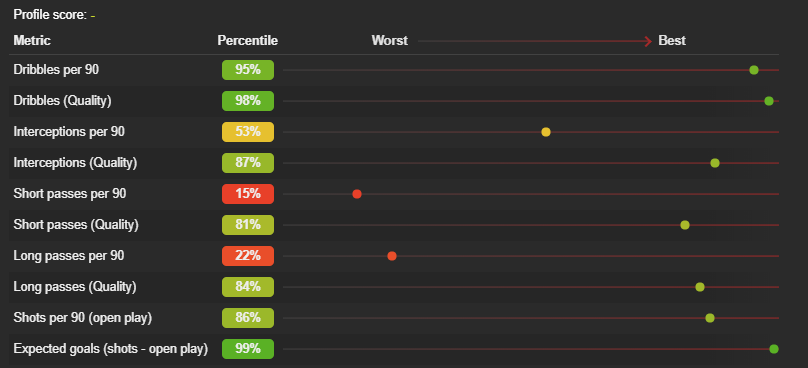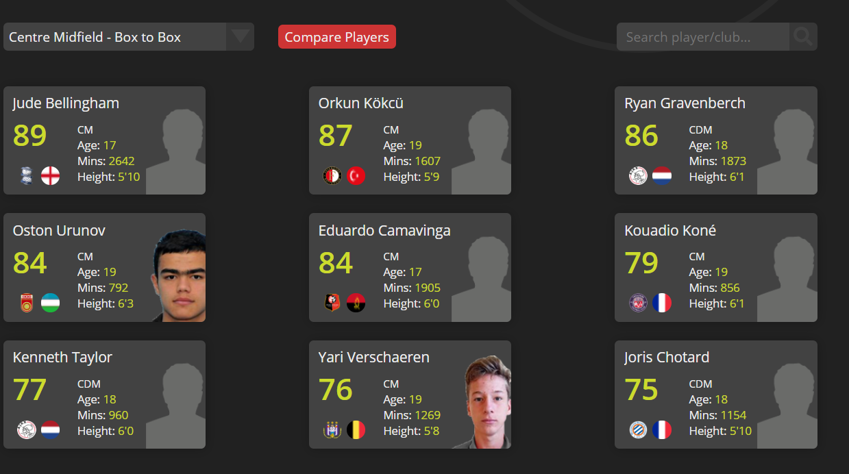Jude Bellingham:
a match for Pogba and Kroos?
Our viewpoint
13 November 2020
On Thursday night, Jude Bellingham made his debut for England: at 17 years and 137 days old, he became England’s third youngest player, behind Theo Walcott and Wayne Rooney.
This caps a promising start to the 2020-21 season for the young midfielder, who has built on his strong performances last season with Birmingham by making 10 appearances for his new club, Borussia Dortmund.
In this article, we use TransferLab’s advanced analytics to look beneath the headline stats and examine both Bellingham’s performances to date and his potential to develop in future years - perhaps to the level of a Paul Pogba or a Toni Kroos.
Bellingham’s breakthrough
Jude Bellingham certainly made an impression in his debut season – so much so that Birmingham City retired the number 22 shirt in recognition of his talent and Borussia Dortmund paid out an initial fee of around £25m to sign Bellingham just a couple of weeks after his 17th birthday.
Bellingham’s breakthrough into the football limelight has not been quite as explosive as the emergence of some other exceptional young players in recent years. Erling Haaland’s breakthrough at Molde and then Red Bull Salzburg, for instance, was exciting, noisy and unapologetic. Bellingham has in contrast excited many of Europe’s top clubs in a more understated way.
So how can Dortmund, a club with a very impressive pedigree for signing promising young players and selling them on a few years later for big profits, justify paying so much money for Bellingham at such a young age? Below, we use TransferLab’s advanced analytics to examine this question.
Why all the excitement?
If we put ourselves in the shoes of the Dortmund recruitment team at the end of last season, what would the data have shown me?
During 41 games over the 2019-20 season with Birmingham, scoring 4 times, Bellingham achieved:
- 2.25 successful dribbles per 90 minutes, which puts him in the top 5% of all centre midfielders.
- 3.75 interceptions per 90 minutes (after adjusting for possession differences between teams), which is just above the average for all centre midfielders.
- 2.6 long passes and 25.2 short passes per 90 minutes, which puts him in the bottom 20% of all centre midfielders based on passing output
- 1.6 shots from open play per 90 minutes, placing him in the top 15%.
These are promising numbers for a player who has just turned 17, but not head-turning. However, these basic statistics tell only a small part of the story.
The Markov-chain model used within @TransferLab assigns a value to every action during a 90-minute match (both attacking and defensive) based on that action’s contribution to the team’s likelihood of scoring or conceding. Using this model, we can assess how effective Bellingham’s performance has been and how much impact his actions have had on the game. This is a key advantage over using just the raw statistics shown above, which only tell us how many times an action has been successfully completed. For instance:
- Dribbling quality – TransferLab’s algorithm rates Bellingham in the top 2% of all centre midfielders, which indicates that, as well as completing more dribbles than most players, those he makes are more incisive than the average midfielder.
- Interception quality – Bellingham is in the top 13% of all centre midfielders, so when he does intercept the ball - which he does about the same number of times as the average player - it usually has a more positive outcome than the typical interception.
- Quality of passing – Bellingham is in the top 20% of all centre midfielders for the quality impact of both his short and long passing game, so although he completes relatively few passes (which may not be surprising given his youth), the impact of his passing is significant.
- Expected goals from shots – he places in the top 1% of centre midfielders for expected goals, indicating an exceptionally strong attacking threat for a player in his position. It should be noted, however, that while central midfield is Bellingham’s most common position, he has also played in more attacking roles.

TransferLab’s metrics indicate that over a wide range of skill sets (dribbling, intercepting, passing, and shooting), Bellingham is already performing at a high level. This is not something which can be identified from the raw statistics, in particular from the number of passes and interceptions Bellingham has completed. As his physicality and tactical awareness improves with age, he can be expected to become even more influential.
What is particularly remarkable is the all-round nature of Bellingham’s game. TransferLab gives you the flexibility to define your own player profile to assess how effective a player is. Based on the “quality” metrics contained within our “box-to-box midfielder” profile (shown below) there is no metric where he rates outside the top 20% of all centre midfielders.

Amongst other young midfielders, Bellingham excels. As a box-to-box midfielder, TransferLab ranks him as the best under 20-year-old in the world, with Orkun Kokcu of Feyenoord, who was linked with Arsenal in the summer, and Ryan Gravenberch of Ajax being his closest comparators.

Just how good will Bellingham become?
Over 2019-20, TransferLab suggests Bellingham performed at a similar level to Declan Rice of West Ham (aged 21) and James Ward-Prowse of Southampton (aged 25), both of whom have been on the fringes of the England national team. This was despite playing in the Championship where TransferLab metrics are adjusted downward relative to the Premier League. Despite the obvious challenges of moving abroad at such a young age, in his first 10 games for Dortmund, Bellingham has matched his performance levels from last season.
TransferLab’s unique ‘age curve’ feature projects that Bellingham will have overtaken Frenkie De Jong of Barcelona in an all-round centre midfield role by age 21 – a player who Barcelona paid €75m for just over a year ago. At his peak, Bellingham is projected to reach a similar level to Paul Pogba and Toni Kroos – both of whom have played instrumental roles in their respective country’s World Cup triumphs.
These projected performance levels are of course not set in stone – bad luck with injuries or difficulty settling in abroad could, for instance, hinder Bellingham’s development – but his potential is undeniable. The sky really is the limit.
The age curves within TransferLab take into account how individual skills vary with age. For example, a player’s dribbling ability starts to decay at a much earlier age to their passing ability. This means that the age curves capture the intricacies of the skill set that you care about, rather than assuming all players in a position perform the same role.
TransferLab is an advanced online data-scouting platform developed as a collaboration between LCP and Analytics FC, a football consultancy which assists football organisations through advice, software and data services. TransferLab is aimed at enhancing the player recruitment process for professional football organisations, including football clubs and player agencies from around the world. For more information click here.


